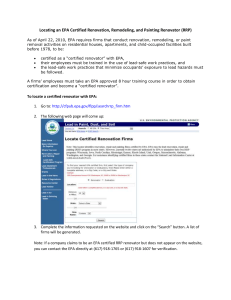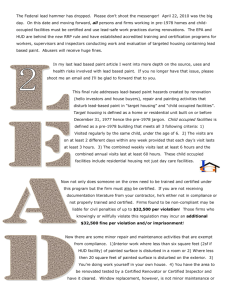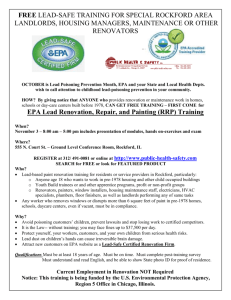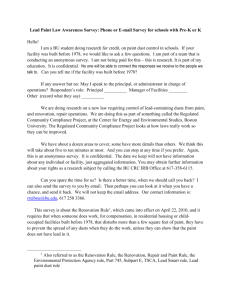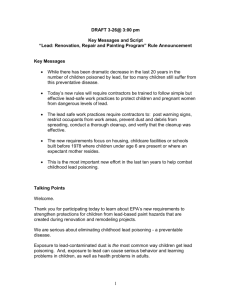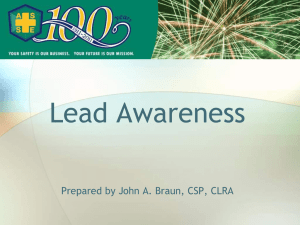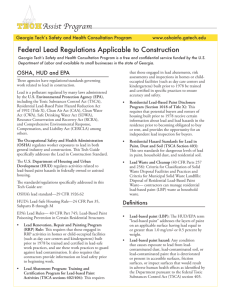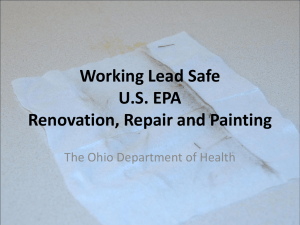Frequently Asked Questions – Renovation, Repair and Painting
advertisement
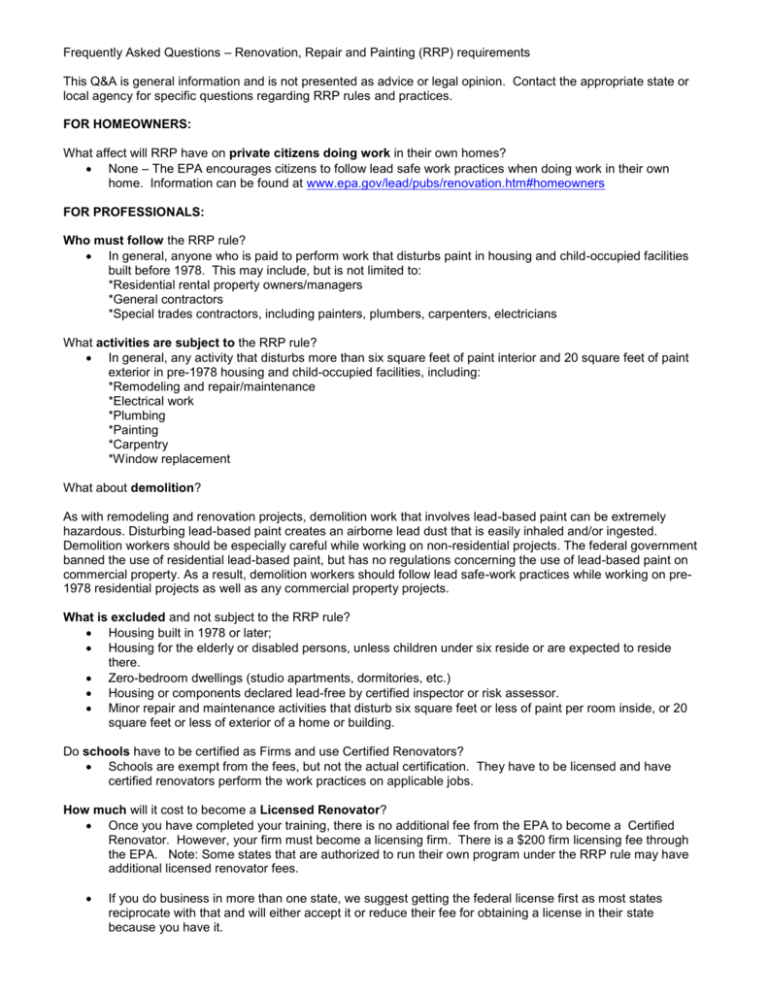
Frequently Asked Questions – Renovation, Repair and Painting (RRP) requirements This Q&A is general information and is not presented as advice or legal opinion. Contact the appropriate state or local agency for specific questions regarding RRP rules and practices. FOR HOMEOWNERS: What affect will RRP have on private citizens doing work in their own homes? None – The EPA encourages citizens to follow lead safe work practices when doing work in their own home. Information can be found at www.epa.gov/lead/pubs/renovation.htm#homeowners FOR PROFESSIONALS: Who must follow the RRP rule? In general, anyone who is paid to perform work that disturbs paint in housing and child-occupied facilities built before 1978. This may include, but is not limited to: *Residential rental property owners/managers *General contractors *Special trades contractors, including painters, plumbers, carpenters, electricians What activities are subject to the RRP rule? In general, any activity that disturbs more than six square feet of paint interior and 20 square feet of paint exterior in pre-1978 housing and child-occupied facilities, including: *Remodeling and repair/maintenance *Electrical work *Plumbing *Painting *Carpentry *Window replacement What about demolition? As with remodeling and renovation projects, demolition work that involves lead-based paint can be extremely hazardous. Disturbing lead-based paint creates an airborne lead dust that is easily inhaled and/or ingested. Demolition workers should be especially careful while working on non-residential projects. The federal government banned the use of residential lead-based paint, but has no regulations concerning the use of lead-based paint on commercial property. As a result, demolition workers should follow lead safe-work practices while working on pre1978 residential projects as well as any commercial property projects. What is excluded and not subject to the RRP rule? Housing built in 1978 or later; Housing for the elderly or disabled persons, unless children under six reside or are expected to reside there. Zero-bedroom dwellings (studio apartments, dormitories, etc.) Housing or components declared lead-free by certified inspector or risk assessor. Minor repair and maintenance activities that disturb six square feet or less of paint per room inside, or 20 square feet or less of exterior of a home or building. Do schools have to be certified as Firms and use Certified Renovators? Schools are exempt from the fees, but not the actual certification. They have to be licensed and have certified renovators perform the work practices on applicable jobs. How much will it cost to become a Licensed Renovator? Once you have completed your training, there is no additional fee from the EPA to become a Certified Renovator. However, your firm must become a licensing firm. There is a $200 firm licensing fee through the EPA. Note: Some states that are authorized to run their own program under the RRP rule may have additional licensed renovator fees. If you do business in more than one state, we suggest getting the federal license first as most states reciprocate with that and will either accept it or reduce their fee for obtaining a license in their state because you have it. How much will it cost to get my people trained? Companies are approved by the EPA to offer training. Visit www.complyability.com to see pricing for the Lead Safe Work Practices training fees. A Certified Renovator may train other employees on the jobsite and must adhere to responsibility and recordkeeping requirements. I have previous lead training – do the new training requirements apply to me? Individuals who have successfully completed an accredited lead abatement worker or supervisor course and are currently certified will not have to take the course, however, they must keep their lead certifications current. KDHE will allow Certified Lead Abatement Supervisors to function as Certified Renovators in Kansas, however, they must follow all RRP work practices standards and renovator responsibilities as published. Individuals who have successfully completed the EPA, Department of HUD, or EPA/HUD model lead paint safety during renovation training course and can show proof of successful completion, need only take a four-hour renovator refresher training course instead of the eight-hour initial renovator training course to become certified. If I become a licensed firm in Kansas and I have to work in Colorado or Missouri does that mean I have to also get EPA certified? And, if an Oklahoma guy gets EPA licensed, does he also have to become Kansas licensed? Yes, they need an EPA license to work in ANY state that is governed by EPA. Each state that runs their own program, like Kansas, requires individual certification Who would enforce this rule in areas that have no code enforcement? KDHE would be the regulator in Kansas; local municipalities will be made aware but are not required to enforce lead-based paint regulations in Kansas. Does RRP require the certification of lead based paint inspectors? Kansas has had classifications and regulations for lead-based paint inspectors and risk assessors in place since 2000. They are not changing due to the RRP. EPA allows for the certification of sampling technicians, what do they do? Kansas does not have this classification of trained individual. What are the general required work practices? Renovations must be performed by licensed firms using a certified renovator and properly trained staff. Firms must post signs clearly defining the work area and warning occupants and other persons not involved in renovation activities to remain outside of the work area. Prior to renovation, the firm must contain the work area so that no dust or debris leaves the work area while the renovation is being performed. Certain practices are prohibited, such as open-flame burning or torching, certain machines and heat gun use to remove lead-based paint. See KDHE’s website for full information on prohibited work practices. Proper disposal of waste from renovations. Are there specific requirements for interior and exterior work? Interior work o Remove all objects or cover appropriately o Close and cover all duct openings o Close windows and doors in the work area – cover doors with plastic sheeting o Cover floor surfaces with taped-down plastic sheeting o Use precaution to ensure people and things are free of dust when leaving work area o After the renovation, the firm must clean the work area until no dust, debris or residue remains. Refer to KDHE website for full information Exterior work o Close all doors and windows within 20 feet of renovation o Ensure that doors within the work area that will be used while the job is being performed are covered with plastic sheeting in a manner that allows workers to pass through while confining dust and debris. o Cover ground extending a minimum of 10 feet beyond the perimeter or a sufficient distance (whichever is greater) to collect falling paint debris. o Where buildings are in close proximity to others or in windy conditions, extra precautions must be taken o After renovation is completed, the firm must appropriate collect and dispose of waste materials. What is clearance verification? Procedure following completion of each job o Option 1: Contact a 3rd party licensed Activity Firm to arrange for a lead-based paint inspector or lead hazard risk assessor to perform post-renovation clearance testing. o Option 2: Licensed Renovation Firm can self-perform the post-renovation lead visual inspection and cleaning verification. There are specific steps to the verification process. Refer to the KDHE website for full information. What are the recordkeeping requirements? Renovation firms must retain all records necessary to show compliance with PRE and RRP for a period of three (3) years following completion of the renovation. Records include: o Disclosure requirements o On-the-job requirements o Work practices requirements o Post work cleaning verification or clearance requirements Can I use power washing on the exterior surfaces? Power washing can be used if all water and all debris are property contained, collected and properly disposed of. Does the plastic have to be taped to the wall when a zip is used? Plastic does not have to be taped if the Zip Wall completely seals and keeps all dust and debris strictly within the work area. When is PPE required? When do people HAVE to wear suits, respirators, gloves, booties, etc.? PPE is mandated when people meet or exceed the OSHA PEL or when an MSDS says that it is necessary.
